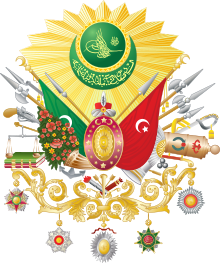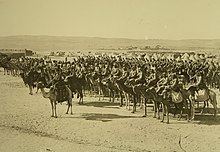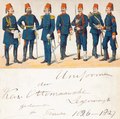
A | B | C | D | E | F | G | H | CH | I | J | K | L | M | N | O | P | Q | R | S | T | U | V | W | X | Y | Z | 0 | 1 | 2 | 3 | 4 | 5 | 6 | 7 | 8 | 9
This article needs additional citations for verification. (June 2021) |
| Modern Ottoman Army | |
|---|---|
| Turkish: Modern Osmanlı Ordusu | |
 | |
| Active | 1842/1861 – 1922 |
| Country | |
| Allegiance | |
| Type | Army |
| Size | ~3,156,000 est. (1914–1918) |
| Garrison/HQ | Constantinople |
| Engagements | World War I (Battle of Gallipoli and Siege of Kut), Arab Revolt, Tripolitanian War, Balkan Wars |
| Commanders | |
| Sultan | |
| Minister of War | Ismail Enver Pasha |
| Military of the Ottoman Empire |
|---|
 |
The Ottoman Army was the army of the Ottoman Empire after the country was reorganized along modern western European lines during the Tanzimat modernization period. It operated during the decline and dissolution of the empire, which roughly occurred between 1861 (though some sources date back to 1842) and 1918, the end of World War I for the Ottomans. The Crimean War was the first war effort in which the modern army took part in, proving itself as a decent force. The last reorganization occurred during the Second Constitutional Era.[1]
The uniforms of the modern army reflected the military uniforms of the western European countries who were the Ottoman army's principal advisors at the time. The Ottoman government considered adopting a Western-style headdress for all personnel within the army, but the fez was favoured as it was more suited to the postures of the Islamic ritual prayer.
French-style uniform and court dress were common during the early stage of the Tanzimat period. After the French defeat in the Franco-Prussian War, the Ottoman government searched for other role models, so German- and British-style uniforms became popular. During World War I, the officer uniforms were mainly based on those of the Ottoman's German allies.
Establishment of the modern army
The shift from the Classical Army (1451–1606) took more than a century and began with the failed attempts of Selim III (r. 1789–1807) and Alemdar Mustafa Pasha (1789–1808),[2] continued through a period of Ottoman military reforms (1826–1858) and finally concluded during the reign of Abdul Hamid II (r. 1876–1909). As early as 1880, Abdul Hamid sought German assistance, which he secured two years later, culminating in the appointment of Lieutenant Colonel Otto Köhler.[3][4] Although the consensus was that Abdul Hamid II favored the modernization of the Ottoman army and the professionalization of the officer corps, [when?] it seems[original research?] that he neglected the military during the last fifteen years of his reign, evidenced by his military budget cuts. The formation of the modern Ottoman army proved a slow process with various ups and downs.[citation needed]
1842–1861
-
Resembling the French line-infantry uniform
-
French-inspired palace guard dress
-
Ottoman soldiers, 1854
-
Ottoman and Russian forces during the Battle of Cetate of 1853-1854
-
Distribution of the Medjidie, after the Battle of Cetate, 1854
-
Landing of the Ottoman army at Eupatoria, E. Morier, 1855
1861–1896
-
Resembling the Imperial German Army dunkelblau uniform
-
Officer of the general staff wearing the Imperial German Army dunkelblau uniform
-
Note the French-inspired Zouave uniform on the right
-
German-inspired dunkelblau uniforms
-
German-inspired dunkelblau uniforms
-
German-inspired dunkelblau uniforms
-
German-inspired dunkelblau uniforms, and a French-inspired Zouave uniform
-
Resembling the Imperial German naval uniform
-
Resembling the Imperial German naval uniform
-
Fire-department personnel wearing the German dunkelblau uniform, and a variant of the fez which resembles the German Pickelhaube
-
Resembling the Prussian artillery uniform
-
Resembling the Prussian artillery uniform
-
Resembling the Prussian Uhlan regiment uniform
-
The Imperial Ottoman Army in 1900
Engagements
- Crimean War
- Russo-Turkish War (1877–1878)
- Greco-Turkish War (1897)
- Italo-Turkish War
- Balkan Wars
- World War I
- Greco-Turkish War (1919–1922)
Units
Combat units
Infantry
The infantry was the backbone of the army. Ottoman infantry was assigned to infiltrate enemy lines and protect territory gained.
Cavalry

The cavalry was losing its efficiency in the late 19th and early 20th centuries. By the end of the empire, there were three cavalry units, the 1st Cavalry Division, the 2nd Cavalry Division, and the 3rd Cavalry Division. These units were the successors to the Hamidiye cavalry formations, which had been disbanded on August 17, 1910. These new regiments were formed into seven cavalry brigades and three independent regiments. They were composed mainly of Kurds, some rural Ottomans and the occasional Armenian.
Hamidiye light cavalry

The Hamidiye was the first trained and organized Kurdish force within the Ottoman army, created by the Ottoman sultan Abdul Hamid II in 1892. It was modeled after the Caucasian Cossack Regiments (i.e. the Persian Cossack Brigade) and tasked to patrol the Russo-Ottoman frontier.[5] Despite its military appearance, organization and potential, the Hamidiye was in no way a cross-tribal force.[6] Cavalrymen quickly found out that they could only be tried through a military court-martial,[7] and were immune to civil administration. Realizing their immunity, they turned their forces into “legalized robber brigades” as they stole grain, harvested fields, drove off herds, and openly stole from shopkeepers.[8]
In 1908, after the overthrow of the Sultan, the Hamidiye Cavalry was disbanded as an organized force but, as they were “tribal forces” before official recognition, they stayed as “tribal forces” after dismemberment. The Hamidiye Cavalry is described as a military disappointment and a failure because of its contribution to tribal feuds.[9]
The decision to disband was made after the 1908 revolution and all of the units returned to their tribes by August 17, 1910. Militarily, Ottoman general staff stated conventional-style military discipline had always been a problem with these units. They were replaced by the reserve cavalry formations.[10]
Artillery

After the Balkan Wars, Ottoman armies began to deploy rapid-firing guns. Artillery began to gain importance and dominated the battlefield.
Non-combatant branches
Engineering
Ottoman engineers had both offensive and defensive functions. They removed physical obstacles created by the enemy, repaired damaged bridges and facilities, and built bridges and other infrastructure to enable infantry operations. Engineers were also expected to create obstacles during retreats and to demolish infrastructure that could be used by the enemy. Each corps had an engineering battalion and each division had an engineering company.
Communication
The communication branch was established in 1882. Its designation was 'telegraph battalion' and its main function was to operate telegraphs. In 1910, the telephone was added to its functions. In 1911, wireless stations were added to the unit. A direct line between İzmir and Derne was established for the first time in 1911, during the Italo-Turkish War. Beginning in 1912 with the Balkan Wars, every corp level unit had a 'telegraph battalion.'
Medical
The medical branch does not have a precise date of origin. During 1908, the second constitutional period, its structure included doctors, surgeons, veterinarians, pharmacists, dentists, chemists, wound-dressers and nurses. They were organized by the Health Department of the Ministry of War.
Military bands
Since the early days of the Ottoman Army, each regiment has had its own band. In 1908, during the second constitutional period, there were 35 military bands in the capital. Each army had two bands. The “Imperial Band” (mızıka-i humayun) consisted of 90 musicians.
Paramilitary units
The Ottoman Gendarmerie was a unit which was sent on police duties among civilian populations. The Gendarmerie was a paramilitary unit because it was not included as part of the state's formal armed forces. It was established in 1903 and organized under infantry gendarmerie and the cavalry gendarmerie. The units were small, with the regiment being the largest. They were distributed across the administrative units under Valis. Their number changed with security needs.
Historically, there was a Gendarmerie performing the same functions before 1903. Since the term Gendarmerie was found only in the Assignment Decrees published in the years following the Edict of Gülhane of 1839, it is assumed that the Gendarmerie organization was founded after that year, but the exact date of 'unit foundation' is not that date. There is also a manual, Asâkir-i Zaptiye Nizâmnâmesi, which was adopted on June 14, 1869, and is accepted as the foundation of the organization.[11] After the 1877–1878 Russo-Turkish War, Ottoman grand vizier Mehmed Said Pasha decided to establish a modern law enforcement organization, so a military mission was formed for the task. After the Young Turk Revolution in 1908, the Gendarmerie achieved great successes, particularly in Rumelia.
In 1909, the Gendarmerie was affiliated with the Ministry of War and its name was changed to the Gendarmerie General Command (Ottoman Turkish: Umûm Jandarma Kumandanlığı). During World War One, especially after the Battle of Sarikamish, Gendarmerie units changed hands from Vali'es (a civilian authority) to the War Ministry (a military authority) to be a combatant branch. This change effectively made them combat units.
Organization

After the Second Constitutional Era, 1908, the Ottoman General Staff published the “Regulation on Military Organisation.” It was adopted on July 9, 1910. Army commands were replaced by “army inspectorates” whose main responsibilities were training and mobilization. The army was to be composed of three parts: the regular army (nizamiye), the reserve army (redif) and the home guard (müstahfız). The “corps” concept was established. Reserve divisions were to be combined into reserve corps and they were to be given artillery units. Units of the regular army would recruit soldiers through the sources of the army inspectorate they belonged to.
The strengths of the Ottoman army were at the highest echelons of its rank structure.[12] Unlike the British or the Germans, the Ottomans had no long service corps of professional non-commissioned officers, which was its weakest point.[12]
Divisions
An infantry division was to be composed of three infantry regiments: a sharpshooter battalion, a field artillery regiment, and an army band. Divisions had operations, intelligence, judiciary, supplies, medical and veterinary departments.
Corps
Corps were composed of three divisions and other ancillary units. They had operations, personnel, judiciary, supplies, secretariat, veterinary, documentation, artillery, engineering and post divisions. Corps consist of 41,000 enlisted and 6,700 animals. During this period, not based on chronological order, the corps that were established were I, II, III, IV, V, VI, VII, VIII, IX, X, XI, XII, XIII, XIV, XV, XVI, XVII, XVIII, XIX, XX, XXI, XXII, XXV, Iraq Area, Halil, I Kaf., II Kaf., Hejaz
Fortified zones
Fortified zones had the same departments of divisions. They added documentation, artillery, engineering, communications and floodlight projectors. During this period the fortified zones that were established were Dardanelles, Bosporus, Chataldja, Adrianople, Smyrna, Erzurum, and Kars.
Army
Army headquarters had corps level departments and also infantry department, cavalry department and field gendarmerie department.
- The 1st Army was formed on September 6, 1843.[13]
- The 2nd Army was originally formed in 1873.[13]
- The 3rd Army was originally formed in the Balkans and headquarters was at Salonica.
- The 4th Army was originally formed in Anatolia.
- The 5th Army was formed on March 24, 1915, and assigned the responsibility of defending the Dardanelles straits in World War I.
- The 6th Army was formed in 1877 and was stationed in Baghdad.
- The 7th Army was formed in 1877 and was stationed in Yemen.
- The 8th Army was formed during World War I.
- The 9th Army was formed during World War I.
Army Group
The Army Group developed late in World War I. The conflicts depleted the Army units, so Army Groups were used to compensate for the lost units and keep the remainder functioning.
In August 1917, the Caucasus Army Group was established. It was a unification of the Second and Third Armies.
In July 1917, the Yildirim Army Group was established. It was a unification of the Sixth and Seventh Armies.
In June 1918, the Eastern Army Group was established. The unit was composed of whatever was left from the Caucasus Army Group united under the Third and Ninth Army.
Zdroj:https://en.wikipedia.org?pojem=Ottoman_Modern_Army
Text je dostupný za podmienok Creative Commons Attribution/Share-Alike License 3.0 Unported; prípadne za ďalších podmienok. Podrobnejšie informácie nájdete na stránke Podmienky použitia.
Antropológia
Aplikované vedy
Bibliometria
Dejiny vedy
Encyklopédie
Filozofia vedy
Forenzné vedy
Humanitné vedy
Knižničná veda
Kryogenika
Kryptológia
Kulturológia
Literárna veda
Medzidisciplinárne oblasti
Metódy kvantitatívnej analýzy
Metavedy
Metodika
Text je dostupný za podmienok Creative
Commons Attribution/Share-Alike License 3.0 Unported; prípadne za ďalších
podmienok.
Podrobnejšie informácie nájdete na stránke Podmienky
použitia.
www.astronomia.sk | www.biologia.sk | www.botanika.sk | www.dejiny.sk | www.economy.sk | www.elektrotechnika.sk | www.estetika.sk | www.farmakologia.sk | www.filozofia.sk | Fyzika | www.futurologia.sk | www.genetika.sk | www.chemia.sk | www.lingvistika.sk | www.politologia.sk | www.psychologia.sk | www.sexuologia.sk | www.sociologia.sk | www.veda.sk I www.zoologia.sk
































